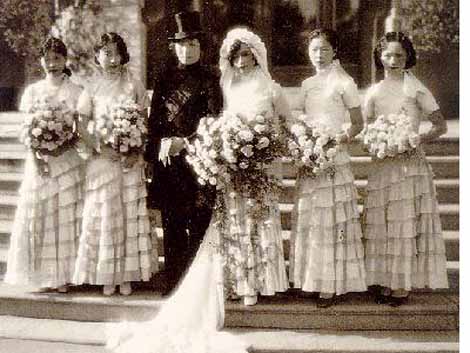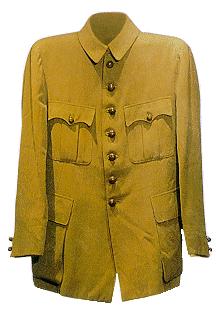
Big Differences between Cities and Countryside
After the 1911 Revolution, the garments changed greatly, and the dresses and the official cap buttons were eliminated. Particularly, hair plait was cut off, but chi-pao (one-piece mandarin robe) still existed. The Blue Short Gown of schoolgirls was the main style, and it gradually became popular.
Along with the emergence of cinema, film stars became eminent persons gradually. Shanghai City became the base camp of women's wear in China. The garments of Guangdong Province and Hong Kong became one of the branches of Shanghai City garments.
Specific Garments of the Republic of China

Shanghai fashion show
The government specified the system of formal dresses of men and women in the first year of the Republic of China (1912-1949). Men had dress suits and routine suits. Dress suits included day suit and evening suit, which were all made of black cloth, trousers and cravats. Routine suits included Western style and Chinese style (e.g. long gown and mandarin jacket). The formal dress of women had collar and was long to the knee with buttons down the front. Skirts were decorated with cartouches in the front and back, both sides were sewn with pleats, and both ends had patterns of knots.

At the wedding ceremony, the urban girl, in full dress of silk, wrapped white gauze over the head and held a white bouquet to celebrate the civilized wedding, while the rural girl was still in a red coat, wore a hat decorated with jewels, rode in red sedan and preserved the old custom.
During the period of the Republic of China, the government specified new dress code, and men wore western-style clothes and Sun Yat-sen's uniform (Chinese tunic suit). These two styles of clothes were foreign styles, and most officials and intellectuals more usually wore them. White garments were worn in the summer, but black or dark garments were worn in other seasons. The style with a mandarin jacket over a long gown was still one of the common dressing styles. The student's clothing with erect collar, three pockets and seven buttons were mainly the uniform of students of universities and colleges. The style with a sleeveless jacket or a waistcoat over a long gown was also a common style. In addition, the common dressing style of rural men and women was a jacket and trousers or covered with a ramie skirt (long or short small skirt fastened on body).
Changes of Women's Costume
Women's costume changed greatly during the period, some kept the Qing Dynasty (1644-1840) style of trousers and clothes with curving front, some imitated western-style with a jacket and a skirt, most schoolgirls wore black silk skirts and short jackets that had a large front, a round lower hem and short sleeves to elbow. The common garments of social women were mainly Chi-pao.
The overall tendency of new garments was divided into two types: one type was the long Chi-paos made of solid-color cloth or printed outside materials; characteristically, laces or patterns were added to the edges, or the small waistcoat and silk scarves were over the jacket. As to the other dressing type, the upper garment and lower skirt were separated.
In the 1920s, people began to wear Chi-pao whose style was mostly the same as that of the Qizhuang garments (garments of banner men) existing at the end of the Qing Dynasty. Later, the cuff was reduced gradually, and embroidered border was not as broad as the previous one. By the end of the 1920s, dressing style was affected by that of Europe and America, and the pattern of chi-pao was changed significantly. By the early 1930s, Chi-pao had been very popular. The main changes of garments in that time were the modifications of collar, sleeve and length, etc. The garments with high collar were popular at first, and the higher collar, the more popular. Gradually, garments with low collars began to be popular, and the lower collar, the more modern. Finally, people wore collarless and sleeveless Chi-pao.
Influence of Foreign Costume
With the inflow of foreign goods into China, western life styles penetrated into the society. Women living in Chinese big cities often attended social activities in the 1930s-1940s. All this resulted into the change of social morals accordingly. Women wore the western-style clothing and skirt together with glass and watch, and sunshade in hands, looking more modern and romantic. The modern fashionable dress of Europe and Japan affected Chinese women in terms of short skirts, underwear and colors, etc. More and more women began to imitate them, and some even imitated the simple dressing style of America. Ladies who liked sports always wore red pleated skirts and used brassiere to replace the old-time bellyband (an underwear that was made of red embroidery cloth and hung from the neck with gold or silver chains, it came down from ancient times). In addition, women's one-piece dress was more popular. During the 1920s-1940s after the founding of the Republic of China, fur coats were still popular in rich families.
The Liuhaitou (hairstyle with bangs in the front of the head) or Yamato Wispy Bun of students studying in Japan was the imitation target of ladies for fashion at the time. The dressing style of slim coat (or clothing), black skirt (without embroidery pattern), watch, elliptic sunglasses, cuspidate leather shoes, handbag and umbrella was brought into China by Japanese Ladies. This dressing style, called the dressing style of Free Lady, first appeared in Guangzhou City at the end of the Guangxu reign, showing that their thoughts and behaviors were open.
The influence of western-style garments on China mainly appeared after the World War II. Many Chinese students studying abroad went to famous cities of Europe and America to seek spouses, so they brought the oriental ornaments to western countries and took western garments and adornments back to China.
The big inflow of foreign cheap goods greatly oppressed the production and consumption of Chinese goods of the same kind, and the sales of Chinese goods went sluggish for a time. In order to open the sales channels of Chinese garments, relevant personages held the Fashion Show of Chinese Garments at the Shanghai Dahua Restaurant on January 9, 1930. It can be considered the first fashion show in China.





